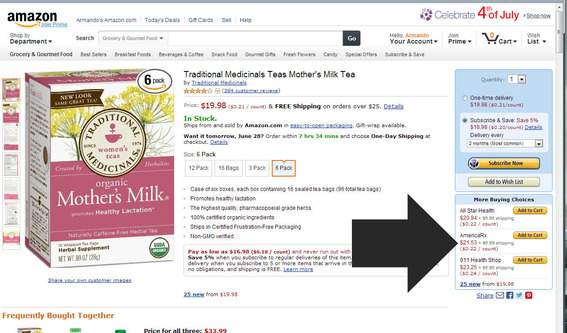Marketplaces like Ebay and Amazon can be a boon for the bottom line since they present your products to millions of interested shoppers. But a huge audience also means that mistakes can be glaring and costly.
Amazon gets something like 21 million visitors a day and more than 100 million page views a day, according to StatsCrop. With so many millions of potential buyers perusing Amazon’s product pages, it is not hard to understand how the marketplace can be a good channel for some online retailers. Similarly, other marketplaces like Ebay, Rakuten, Sears, or Newegg can also be a good sales channel for online retailers that want to reach beyond a website or a pay-per-click advertising campaign.
Unfortunately, listing dozen, hundreds, or even thousands of products on a marketplace can be a serious task that sometimes leads to expensive or embarrassing mistakes.
Mistake No. 1: Your Prices Are too Low
On Amazon, sellers typically share common product images and product descriptions. Often the only ways to compete are with reviews or on price. The latter, selling on price, is something that a merchant must be prepared to do, but often a retailer will miscalculate marketplace selling fees, underestimate shipping costs, or otherwise price an item too low.
Most often this mistake happens when a seller, busy posting products to Amazon or Rakuten, forgets to include the marketplace per-order fee in the pricing calculation.
As an example, I recently sold an item on Amazon for $55.96 plus $4.49 in shipping and handling, for a total of $60.45. Amazon took $9.06 in fees, leaving $51.39. The actual shipping cost was approximately $7.00 and the item cost $42.48, leaving a slim $1.91 in profit. This is an acceptable margin for the product, but I mention it because a week earlier a competitor had been selling the same item on Amazon for $49.99. This seller likely had not properly calculated the selling fee and was losing money.
Mistake No. 2: Your Description or Product Is Wrong
Marketplaces don’t want every seller creating a new listing for every product. Imagine what would happen if Rakuten showed the same product 25 times on a product category page. Shoppers would be confused and sales would decrease.
As a result, marketplaces typically ask sellers to provide a universal product code (UPC), an international standard book number (ISBN), or a similar unique identifier. This number is used to associate several sellers with a single product listing.

Amazon associates several sellers with a single product description.
If there is an error in the code or a marketer accidently associates a product with the wrong code, a huge problem arises.
For example, I’m aware of a retailer that added a listing on Amazon using a script — for a single, chain-link panel. The retailer had been selling the chain-link panel for years and had a UPC associated with the panel in its database. An automatic listing script dutifully compared UPCs and adding the product to Amazon. But UPCs are not always constant, and the manufacturer had changed this one. As a result the retailer’s single, chain-link panel, which sold for $79.99, was associated with a 10-foot by 15-foot chain-link dog run that sold for almost $400.00.
The retailer sold more than a dozen of the “dog runs” in moments, creating a customer satisfaction nightmare. This is certainly a mistake that you’ll want to avoid.
Mistake No. 3: You Mismanaged your Inventory
Inventory can be a source of frequent mistakes for retailers selling across several channels, including marketplaces.
The problem usually arises when retail marketers or managers don’t allocate inventory to a particular sales channel or don’t have a good, near-real-time inventory update system.
Imagine that a retailer has an online store, a small boutique in a strip mall, and is selling on the Sears marketplace. If that retailer has five widgets hanging on the shelf in the physical store, but also has those same five widgets included in its website’s available inventory and in the Sears marketplace’s available inventory, it is possible that the retailer will sell more widgets than are actually on hand.
This means that a customer somewhere won’t get the widget she was expecting. She might never purchase from that retailer again and the Sears marketplace might even prevent the retailer from listing items in the future.
The best practice here is to allocate inventory to each channel. Hang three widgets on the shelf in the physical store, and make one widget available in the online store and in the marketplace. When a widget is sold, it is easier to reallocate than it is to deal with an upset customer.
Mistake No. 4: You Missed a Marketing Opportunity
In addition to the direct sales that they generate, online marketplaces like Ebay, Newegg, and Amazon are also a good way to market to new prospects and potentially build lasting customer relationships.
A study from Adobe indicated that customers who return for a second purchase typically spend three times as much as first-time buyers, and customers who return to make three or more purchases typically spend five times as much as a first time buyer. Given this data, it is important to encourage shoppers to be loyal and return for future purchases.
Online merchants selling through marketplaces often make the mistake of missing marketing opportunities.
When you sell something on Ebay, for example, include a coupon in the box for a future purchase on your store website.
If you make a sale on Amazon, which restricts in-package marketing, consider sending a postcard as a follow up. That postcard might thank the shopper for the order and let her know that you have a website too.



